Let’s Pontificate
To Rome, where Pope Paul interrupts a meeting of his council to greet his grandson, Allesandro. Pope Paul was a Farnese Pope, one of the great Italian noble houses, and for Popes at this time your house and your family and the loyalty you could rely on from them, in turn for what you could provide for them was a central power base to be used. In many ways they operated like proto-mafiosi. Paul had a mistress (Silvia Ruffini) for most of his life and they had 5 children, which despite being technically illegitimate all got his family name. Paul spent a lot of the early part of his papacy wrestling family lands back and grabbing new ones to create a Duchy to give to his oldest son and they would add more as time went on.
The opportunity and need to hold on to power created by his election as Pope meant that Paul created some of the Papacy’s most notorious cases of nepotism.

Alessandro was made a Cardinal by Pope Paul at 14, he made another grandson Guido a Cardinal at 16, and later on in his reign Paul made Alessandro’s brother Ranuccio yet another pubescent Cardinal at 15. This being a job at the very top of the church hierarchy, wielding a lot of power and supposed to be the capstone to a long church career for the very great, well learned and well connected, not someone’s first work experience posting.
It also gave the Farnese family the weird situation of the titles and lands they held all going to younger grandsons because the opportunity of building a Vatican powerbase was too good to pass up, and a pre puberty cardinal was too much even for Paul III here. Anyway, I like this little glimpse into Italian power politics, particularly, as he grew up to he his grandfather’s chief Vatican enforcer, little Alessandro’s confident and slightly burly ‘Sure’ and Paul’s delight that he’s either telling the truth or lying well enough that it doesn’t matter.
Once he’s got everyone’s compliance on that they move on to whether or not to commission Michelangelo to create a ‘Last Judgement’ for the altar wall of the Sistine Chapel.
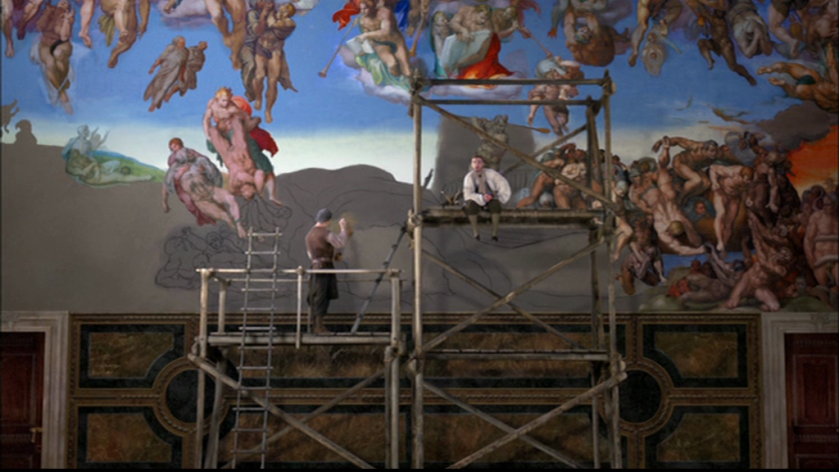
For those with doubts about it, Pope Paul is full of power moves today.

Finally they get onto Henry. Paul says he will tell them a story, fortunately it is a brief one. When he was a boy Pope Paul got pulled out to sea by a strong tide, he prayed, and God sent a friendly wave that took him back to shore.  Oh, it is beautifully delivered, but once again the Papacy is not actually doing anything. They’re hoping that Henry trips himself up, but they remain confident that it will happen.
Oh, it is beautifully delivered, but once again the Papacy is not actually doing anything. They’re hoping that Henry trips himself up, but they remain confident that it will happen.
Finger Pointing at Foreigners
Over at the Littlest Monastery the less exalted asset strippers have arrived and they are going in with a vengeance, getting close to physical violence several times and taking everything, right down to the chickens. At the beginning we don’t know who they are (Although their repeated yells of “Allez, Allez” give us a big clue) but a friar asks Father Abbot, who tells him.

But is seems unlikely that they would have been. There is a tradition that Cromwell used foreign mercenaries during the dissolution of the monasteries, but no real evidence for it. The Huguenot large scale migrations to England happened well after this, with the first of significance happening in Edward’s reign, more in Elizabeth’s and the largest around 1708, over 150 years after this point. These are the same times you see records of Huguenots buying up old church property, not back in the middle of the Reformation.
You know who was doing that, particularly in this first wave of closing the smaller monasteries? The English nobility. The Duke of Norfolk (famously a Catholic Remainer) was the first in buying up religious houses (Thetford Priory, Sibton, Bungay) followed by other nobles. They bought them at knock down prices and moved out the residents, who had decided that the something they could get from a local noble was better than the nothing they would get if they waited until the King and Cromwell got to them, and for a while there was no legal way for Cromwell and the King to stop it, because once they had bought it, well, dissolution achieved.
Still, pointing at the Huguenots who had bought it and moved in fifty years later and saying they did it was made plausible by Cromwell’s past as a mercenary in foreign lands, and a lot easier than explaining just exactly what it was great-grandfather did during the dissolution, which was probably dodgy as hell and how your family afforded the farm.
The Queen
Back in Whitehall Anne marches down the great hall flanked by her ladies at a smart pace, the crowd parts in front of her, and there’s a gratifying chorus of “Your majesty”‘s as her heels smack against the wooden floor with confidence. 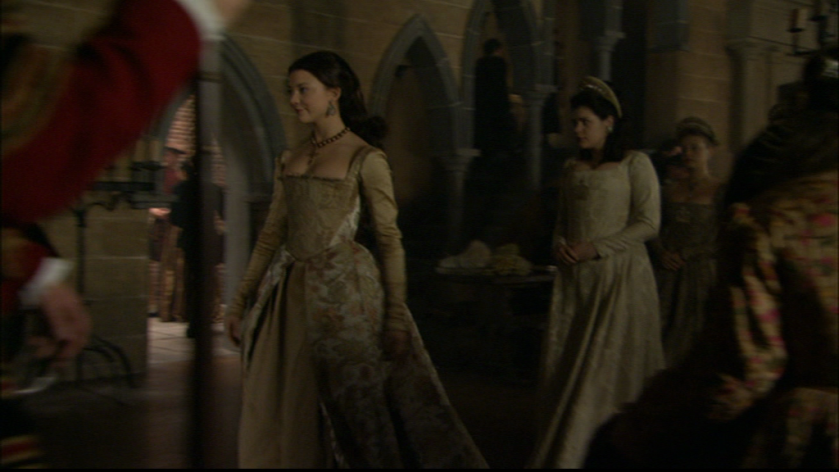
She arrives, and tells the King’s chamberlain that she’s here to see the King. Only to be told that the King isn’t even in the palace, he’s gone out hunting with the Duke of Suffolk. Suffolk’s name whips the confidence out from under her, she’s always fretted over the fact that Suffolk damn near procured a mistress for Henry to have his first affair of their marriage. 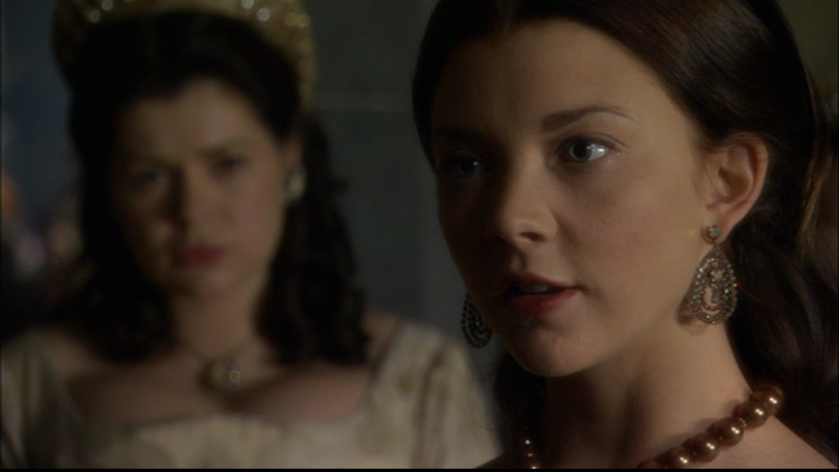 And Anne tries to save face by saying that she now remembers that the King told her, with the humiliation that the chamberlain certainly knows he didn’t, and she knows he knows that.
And Anne tries to save face by saying that she now remembers that the King told her, with the humiliation that the chamberlain certainly knows he didn’t, and she knows he knows that.
She starts to walk away, confidence of the morning evaporated. The bowings and scrapings and “Your majesty”‘s are now just multiple watching faces she must keep her composure in front of and those clacks of her heels get faster and faster on the way back because this time because she wants to run. 
Today Wolf Hall is closer
The Tudors…is not about to have its most Actual Historical day. I love this series and this is one of my favorite episodes. It’s fantastic drama. It’s just going to take several walks away from Actual History this week, but it does have its reasons.
First, The Tudors has romanticised the hell out of Henry and Jane Seymour’s meeting. Henry had a strong tendency to take up with women who worked for his current wife. Jane Seymour became a Lady in Waiting for Katherine in 1532, and had been working for Anne since she became Queen. Henry’s attitude to her might well have changed during a visit to Wolfhall, but that was on a progress, with a large chunk of the court in tow, not a meet cute on a spontaneous hunting trip. And by that point he would have known her (maybe not closely, but he would have known her) for years.
Henry was an English monarch that was unusually secure on his throne, with an increasing paranoia about not getting a male heir, so he could marry where he wanted. What he wanted was what caught his eye, and after 20 years of the redoubtable and politically capable Katherine of Aragon and a decade of the brilliant and cutting Anne Boleyn he looked again at mild mannered Jane Seymour who had been hanging around doing her job for years while he picked and then discarded the prettier ladies in waiting as mistresses and finally decided “That. That’s what I could do with”.
In The Tudors Henry and Brandon are hunting when Henry rejects going back to the palace and wonders if there is anywhere local they could stay. 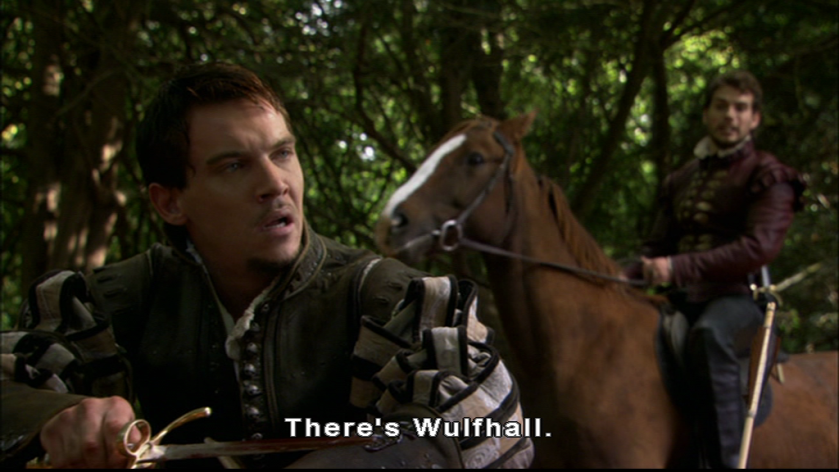
Wolfhall was in Wiltshire, about 70 miles from London. That’s just about possible for a modern endurance horse and rider that have trained for several months. It’s not a distance you accidentally cover while hunting, or consider returning from in an afternoon.
Anyway, Henry has to be reminded who lives there, but when Brandon tells him it’s Sir John Seymour he brightens up, and that’s certainly where I noticed just how depressed and subdued he’s been since Sir Thomas More died. For a moment he lights up again. Henry remembers Sir John from his first campaign in France, when he was younger and everything was simpler and great achievements could be made in an afternoon instead of a decade. He likes the idea of surprising him with a visit and he and Brandon ride off.
We briefly return to the Littlest Monastery, where Father Abbot is the last man out, surveying the remains of their ruined home. 
So, this is a bit of a change. I think this is scene is here for a several reasons. It ends this story from the rough edge of the reformation we’ve had this episode, it gives a break between Henry and Brandon deciding to go to and arriving at Wolfhall, it feeds into the theme of things ending, and sadness we’re going into, and it’s foreshadowing the big conflict for the first half of Season 3. While the score is going to be quite mournful for the next few minutes, in this part it has some drums in it, a background of tension because here are all the ingredients for the great rebellion of Henry’s reign: The Pilgrimage of Grace, just waiting for the temperature to rise and the pot to get stirred.
Now, for the next five to ten minutes the action is going to be cut three ways – Henry and Brandon at Wolfhall with the Seymours, the deathbed of Katherine of Aragon at The More and Anne Boleyn at Whitehall. Three Queens in one episode. The cuts are fast for The Tudors, which normally allows its scenes more room to breathe, mashing the three worlds together.
Henry and Brandon arrive at Wolfhall which shines in the setting sun. 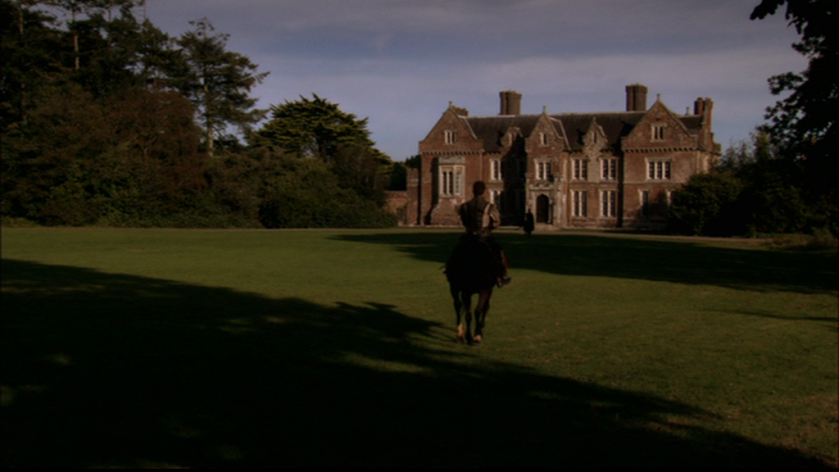
Brandon goes inside and rouses the house, with the news of an unexpected visit and honour. 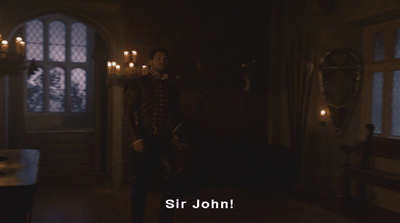
And Henry gets to experience one of the pleasures of Kingship, to unexpectedly make someone’s year just by turning up. He also gets to spend a night away from the pressures of court, like a little vacation for him.
Two Out of Three Feel Bad
There’s no such opportunity for Anne. Just as Henry is starting to get some daylight on his depression, Anne is sinking further into it, staring intently into the fire at Whitehall, as Mark Smeaton plays a lament on the violin. 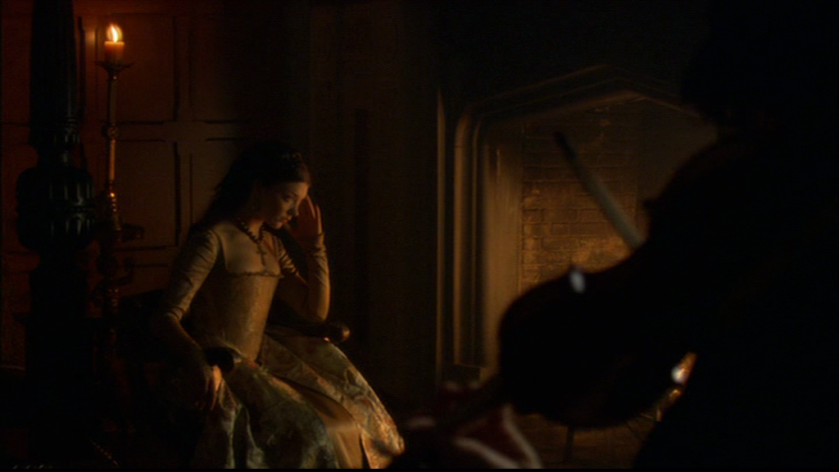
The music continues as we cut to Elizabeth Darrell praying next to the bedside of a dying Katherine of Aragon.
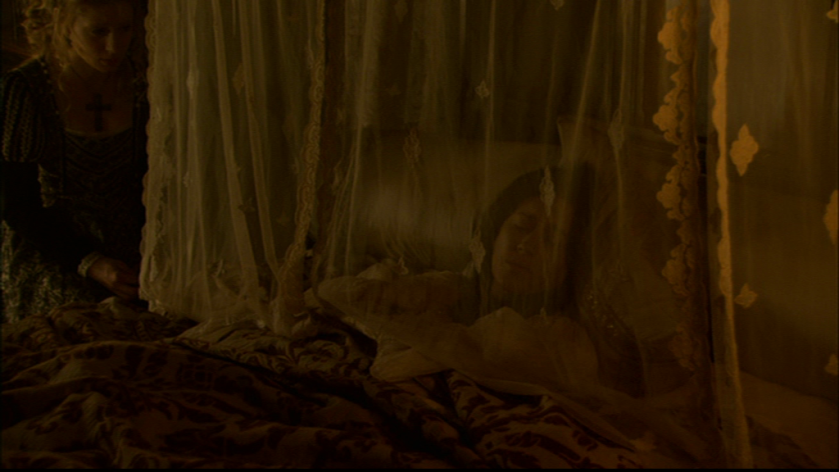
Past and Future Victories
At Wolfhall Sir John, Brandon and Henry are all reminiscing about the Battle of the Spurs, Henry’s only real military victory up to this point. Sir John proves himself an adept courtier.
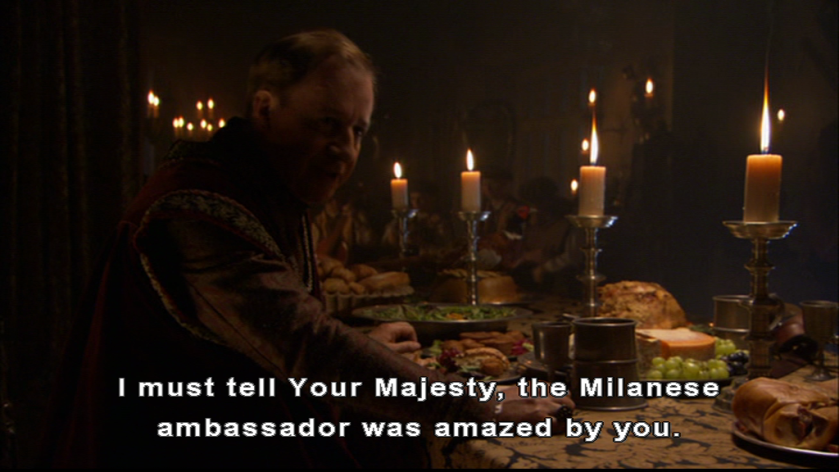
It all comes with a great impression of the ambassador and Brandon is amused, but it is this moment where Henry begins to retreat from the conversation. As it goes on, Sir John and Brandon continue perhaps even more boisterously, trying to get back the atmosphere they had before, but all Henry can manage is the odd nod and smile.
Back at The More (although Katherine actually died at Kimbolton Castle) Katherine gets one moment of pure happiness before her death. She believes she gets a visit from Mary.  And so do I. The recently deceased Lord Darcy appears to Brandon in Season 4 and gives the thesis of the supernatural elements in The Tudors : “The recent dead…We go here and there…to make sure our relatives are well…rushing here and there like doubles of our earthly selves. And when we have settled all our accounts the angels will come to take us to the place of rest”. It comes to a head in the final episode of Season 4 when Henry’s first three Queens come to visit him, and gets built up over all four seasons. And this is part of the build up.
And so do I. The recently deceased Lord Darcy appears to Brandon in Season 4 and gives the thesis of the supernatural elements in The Tudors : “The recent dead…We go here and there…to make sure our relatives are well…rushing here and there like doubles of our earthly selves. And when we have settled all our accounts the angels will come to take us to the place of rest”. It comes to a head in the final episode of Season 4 when Henry’s first three Queens come to visit him, and gets built up over all four seasons. And this is part of the build up.
I think this is Mary I after her own death because she would have desperately wanted to comfort her mother before hers, definitely an account Mary would have wanted to settle, because that possible visit from Anne to Thomas Wyatt earlier this season means that such visits aren’t necessarily tied to the timeline, because Mary doesn’t say a word and appears to be unable to while also being incredibly emotional, and look at what she’s wearing on her head.

In a series with very solid, if occasional, supernatural elements that’s my thesis of what this scene is. And I do love the way the Tudors does the supernatural, giving us a flavour of that era’s more magical worldview without letting it dominate or derail the story line, and being consistent with it. And we actually get some real emotion in there, Mary I finally getting to see her mother again after all of their troubles is a really moving concept.
Elizabeth Darrell comes back in and Mary has gone. Katherine shares that her daughter has visited her, and despite seeing no evidence for that and knowing it’s impossible, Elizabeth displays kindness by simply saying “Yes madam, I know.”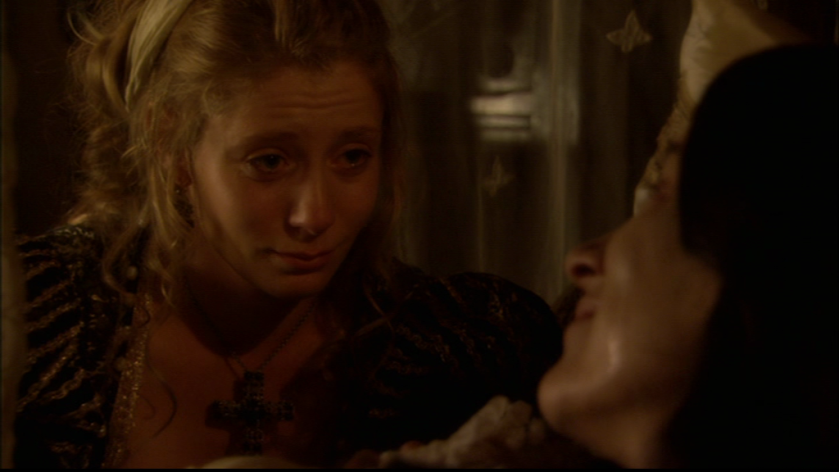 She wants to know if she can get Katherine a doctor, but Katherine is ready to die as God chooses, despite being in near constant pain at this point.
She wants to know if she can get Katherine a doctor, but Katherine is ready to die as God chooses, despite being in near constant pain at this point.
The Edge of a Golden World
The music at the end of the scene with Katherine is a solo violin and turns out to be what Mark Smeaton was playing for Anne.  At Wolfhall, Henry is distant from the conversation, where Brandon and Sir John are still joyfully swapping anecdotes about their past. They’re having fun, but Henry’s doing the 16th Century equivalent of listening to a lot of Adele on repeat, when…
At Wolfhall, Henry is distant from the conversation, where Brandon and Sir John are still joyfully swapping anecdotes about their past. They’re having fun, but Henry’s doing the 16th Century equivalent of listening to a lot of Adele on repeat, when…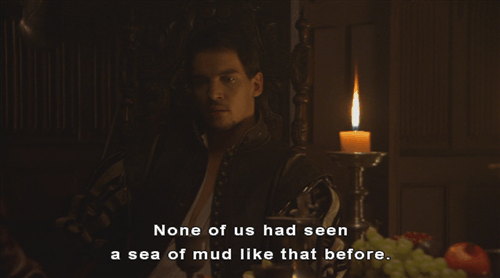 Now it’s absolutely right for the scene, but let’s take a moment to recognise that she’s 2 hours late to the party, with dressed hair and a formal gown in sparkling virginal white from the ‘Medieval Princess’ range. Her modesty may be entirely natural but that’s not an unstudied look. And sure enough Henry’s as bowled over as a drowning man coming up for a breath of air.
Now it’s absolutely right for the scene, but let’s take a moment to recognise that she’s 2 hours late to the party, with dressed hair and a formal gown in sparkling virginal white from the ‘Medieval Princess’ range. Her modesty may be entirely natural but that’s not an unstudied look. And sure enough Henry’s as bowled over as a drowning man coming up for a breath of air. 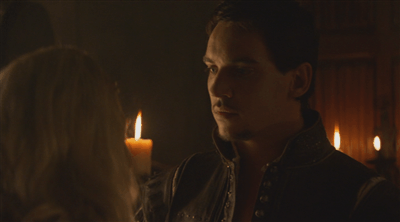 Henry’s got his own glimpse of a Golden World, one that, for a long time, he has felt was an impossible distance away. Suddenly he can see it, and this time around the obstacle blocking it is going to be Anne.
Henry’s got his own glimpse of a Golden World, one that, for a long time, he has felt was an impossible distance away. Suddenly he can see it, and this time around the obstacle blocking it is going to be Anne.
Crop You at The Neck
Anne has summoned Cromwell for an argument about religious policy. When Cromwell says that fraud and laxity were found to be commonplace in the monasteries, Anne counterpoints. 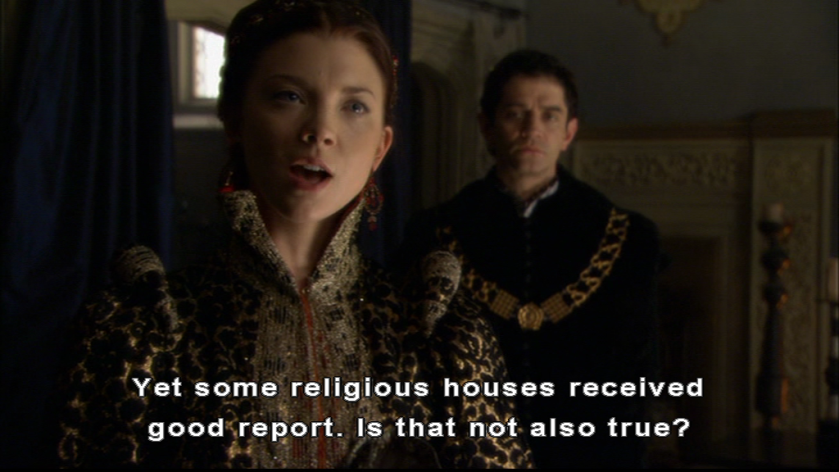 She wants to know why all the money is going into the King’s treasury, wasn’t the plan to use some of that money for charitable causes and education funding? Cromwell looks a bit confused as to where this is all coming from and points out that her father and brother are behind these policies (Translation – The Boleyn faction is fine with this, why is it a problem for you?) and that it is the King’s policy.
She wants to know why all the money is going into the King’s treasury, wasn’t the plan to use some of that money for charitable causes and education funding? Cromwell looks a bit confused as to where this is all coming from and points out that her father and brother are behind these policies (Translation – The Boleyn faction is fine with this, why is it a problem for you?) and that it is the King’s policy. 
So why on earth is she doing this? And doing it now? It’s the second time recently she’s been pushing forward from a position of weakness. Well, there’s the ever present rule, when upset by something Henry has done blame his advisors, because you can’t blame Henry, and there was an Actual Historical significant rift between her and Cromwell over this religious policy.
Also, maybe she’s employing the technique her father employs, when threatened and feeling weak try to bully your way out of it and belittle everyone around you. Except, as evidenced by Cromwells “Are you…really doing this?” expression he is no brother George, or Wolsey for that matter, and the pieces are all in a very different position from the last time she dominated the game.
Anne needs to be pregnant, like yesterday.
Farewell Great Queen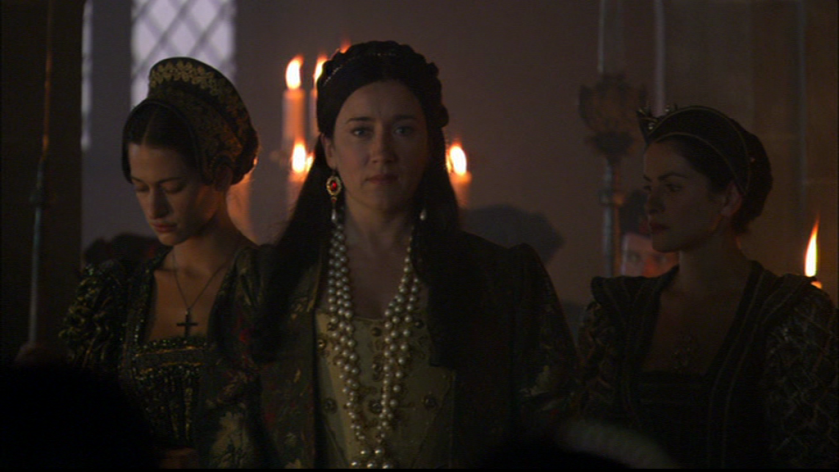
Maria Doyle Kennedy‘s Katherine of Aragon is about to die. Let’s start with a few words about this performance. Most critics or people who never got into The Tudors manage to agree that The Tudors‘ Katherine of Aragon is pretty great. And that’s at least partly true because for once the script allowed a performance of Katherine of Aragon to be pretty great. Joanne Whalley’s Katherine in Wolf Hall might have been great (although it’s a very severe character she was given) but with only 3 or 4 scenes and starting as the Great Divorce begins she just never gets chance to show it. Most adaptations of this period and subject, like Wolf Hall, only give you the divorce era Katherine, and only show a post First Brexit increasingly insular England, so we miss her international importance, which politically was what Katherine of Aragon was all about. We get the martyr or the bitter woman or a mixture of both, until The Tudors we never really got a good look at Katherine the Queen.  The first season of The Tudors (truncated and time manipulating as it was, trying to cover over 20 years in 10 episodes) is what gave Maria Doyle Kennedy her chance to give us, finally, a fully rounded, placed in international context Katherine of Aragon. And a glimpse, albeit a short one, of this woman when her marriage was still alive and functional. We also finally saw just how vast and powerful her family was in comparison to the relatively provincial Tudors. Charlotte Hope might be getting an even better opportunity in the currently running The Spanish Princess, the first in depth adaptation of Katherine’s youth that actually includes her family, but Starz have made it very hard to get hold of in the UK, (I’ve got Sky, Netflix and Amazon Prime and I still can’t watch it without paying more money) and I’ve been burned by Phillipa Gregory adaptations before. I’m waiting for the dvd or a more general streaming on that one.
The first season of The Tudors (truncated and time manipulating as it was, trying to cover over 20 years in 10 episodes) is what gave Maria Doyle Kennedy her chance to give us, finally, a fully rounded, placed in international context Katherine of Aragon. And a glimpse, albeit a short one, of this woman when her marriage was still alive and functional. We also finally saw just how vast and powerful her family was in comparison to the relatively provincial Tudors. Charlotte Hope might be getting an even better opportunity in the currently running The Spanish Princess, the first in depth adaptation of Katherine’s youth that actually includes her family, but Starz have made it very hard to get hold of in the UK, (I’ve got Sky, Netflix and Amazon Prime and I still can’t watch it without paying more money) and I’ve been burned by Phillipa Gregory adaptations before. I’m waiting for the dvd or a more general streaming on that one. 
Given this opportunity Doyle Kennedy nailed it, and kept nailing it. We got Katherine the wife, the mother, the politician, the jealous and only very occasionally petty, the defiant, the learned, the pious and the stoic. A woman who managed to take on the disadvantages of being female in this period and from time to time managed to turn them into advantages by using them for leverage or showing their hypocrisy (I refer you to the dutiful wife’s best practice agreement and “Go and argue it in Rome with lots of important men, instead of here, with one poor woman”). A woman of gentle humour and deep political knowledge who loved her daughter and more incredibly her husband to her end.
And here we are.
Leaving on a beautiful lie
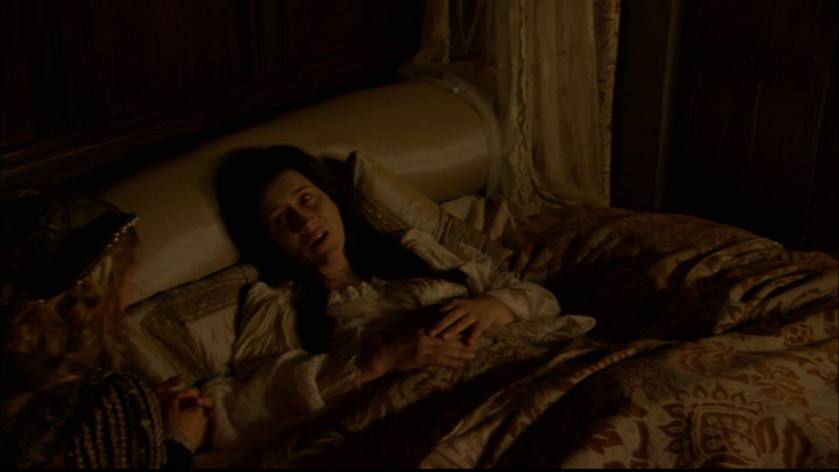
Katherine of Aragon’s last letter, her famous and much quoted last letter is almost certainly a fake. It was reported as Actual History, by Fraser, Weir etc. in their popular histories right up until recently but if you look carefully, Fraser was really evasive about it in her footnotes, and Weir liked to mention it but skip by very quickly. If this document was ever considered in any detail there’s a tendency to say the sources for it aren’t great (while not actually saying what they are). It wasn’t until Giles Tremlett’s Catherine of Aragon (first published in 2010 after the last season of The Tudors aired) that anyone nailed their colours to the mast and called it ‘almost certainly a fabrication.’.
Which is a shame, because it’s great, and The Tudors went all out on it. Hirst actually improved on it with some subtle editing, softening the tone a bit, and moving the bit about finances to the beginning to make the whole end of the letter a loving speech to Henry. And Doyle Kennedy’s performance is amazing, allowing a well spring of love to flow through the words.
Katherine is pictured with Elizabeth Darrell being the main lady in waiting attending her on her deathbed. Elizabeth was there, but it was Maria de Salinas, one of Katherine’s original ladies in waiting from Spain whose arms Katherine died in. Maria (mother to the Duchess of Suffolk, Brandon’s wife) had forced her way into the Castle after having been denied entrance when she heard Katherine was dying.
Katherine starts with her basic will for which there is some historical evidence. She asks for financial bequests to her servants and arrangements for her burial. Neither of which Henry honoured. It took Mary I becoming Queen for the bequests to get paid. Katherine was buried at Peterborough Cathedral, with a travesty of a funeral whose oration was preached by radical Protestant (chosen by Anne Boleyn) who managed to claim that Katherine had accepted the Royal Supremacy and also that she actually wasn’t married to Henry after all before she died. Peterborough has done well by Katherine of Aragon ever since though, as their most illustrious burial, (Mary, Queen of Scots was also buried there but she got moved to Westminster Abbey by James I) with regular memorial services and a grand grave, complete with a title she would have approved of.

The score starts up, with low strings and a single Oboe, as she talks about her bequests to her daughter. And then she says she must write to the King. Her writing is inter cut with Henry’s reaction reading the letter.
My Dear Lord and dear husband, I commend me unto you. The hour of my death draws fast on and, my case being such, the tender love I owe you forces me to put you in remembrance of the health and safeguard of your soul…
This could have a lot more edge and judgement to it but this Katherine is all love and sincerity now. That worry for his soul, and her forgiveness is genuine. The strings have warmed up and the score has become appropriately grand as she finishes.  She asks Elizabeth to help her, and signs the letter ‘Katherine the Queen’, iron to the end on that point, and dies almost immediately afterwards to the distress of her household, and Henry’s deep sorrow.
She asks Elizabeth to help her, and signs the letter ‘Katherine the Queen’, iron to the end on that point, and dies almost immediately afterwards to the distress of her household, and Henry’s deep sorrow. 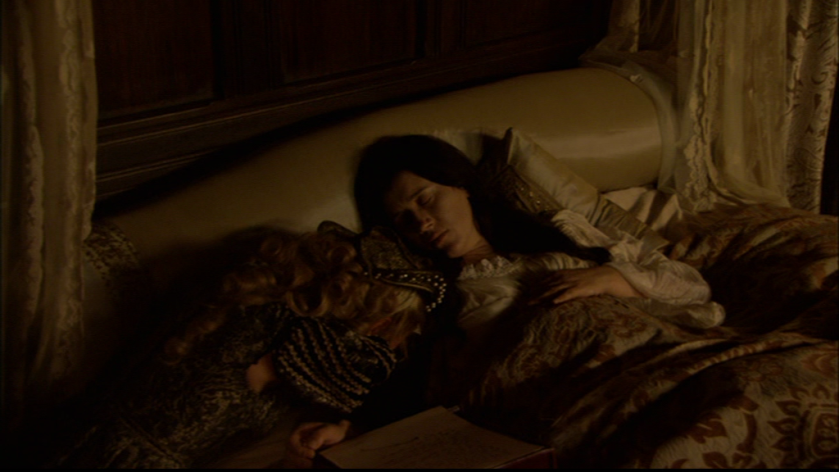
For Anne, though
Nan Saville comes rushing in to tell Queen Anne, who is reading and takes the news with some satisfaction. 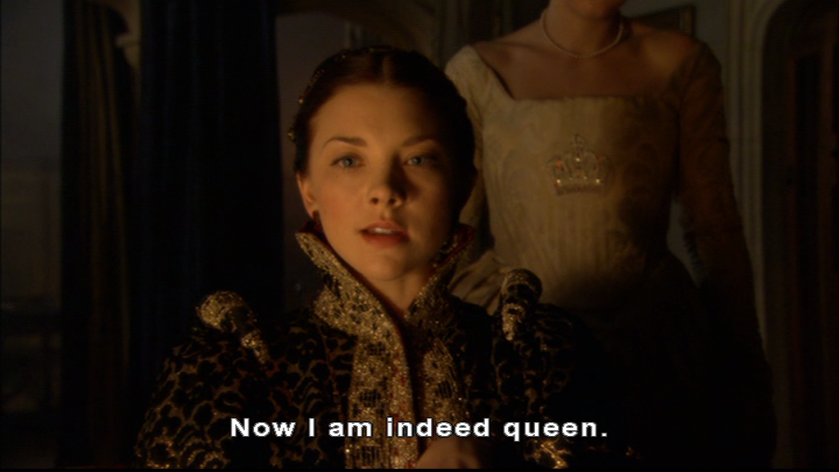
Leaving aside a more beautiful truth
Katherine of Aragon’s death has some severe consequences for the secondary cast, too. Sir Thomas Wyatt, having presumably heard about Katherine’s death comes riding up to the More to take what must be the newly free Mistress Darrell away from all this. He enters the now darkened house and calls for her.  Only to find that in her moment of greatest distress she has taken the dreadful step of suicide. He falls to his knees in shock and sorrow, whispering her name in incomprehension.
Only to find that in her moment of greatest distress she has taken the dreadful step of suicide. He falls to his knees in shock and sorrow, whispering her name in incomprehension. 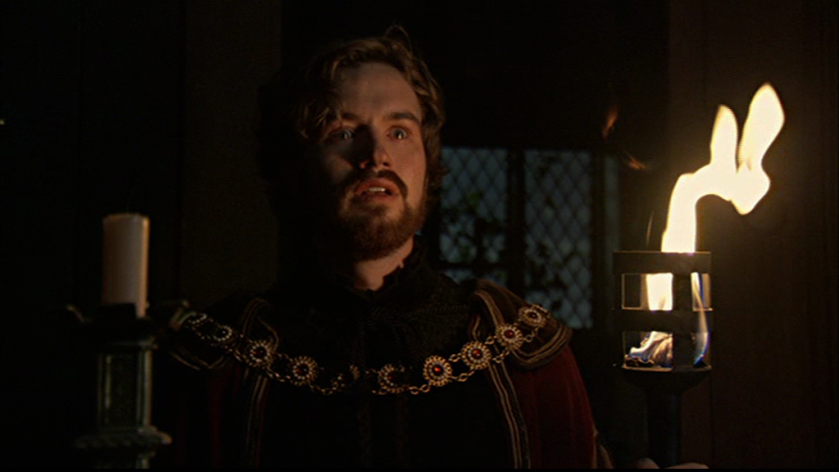
It’s just so incredibly sad. Makes you wish you lived in a different, better world.
Maybe one more like this…
Imagine that Thomas and Elizabeth had probably met before this, but only got together about a year after Anne Boleyn’s death. Wyatt had hit an incredibly low point, but with Elizabeth he slowly started to heal. Wyatt was famously described by C S Lewis as ‘Always in love with women he dislikes’ and had written almost all his poetry to women of an unattainable, quite chilly ideal until Elizabeth. But of her he wrote
“The unfeigned cheer of Phillys hath the place
that Brunet had: She hath and ever shall”
And he meant it, and she did. Their relationship survived changes of fortune and even Thomas being court ordered to return to his wife after getting arrested again in 1541. Elizabeth was a devout Catholic, serving Katherine of Aragon until her death and refusing to take the Oath of Supremacy, but keeping her life, unlike Sir Thomas More, so being under the protection of someone powerful while also being a bit obscure had its advantages.
They had a home and three children, but only one survived to adulthood; Francis, who took the surname Darrell. Thomas made sure in the good times that both would be well provided for, leaving them their own land and property when he died of an untimely fever in 1542, just before reaching 40. Elizabeth lived longer, dying in 1556.
It was no fairy tale, but it was a life.
Prefer that? Wish you lived in that world?
Well, congratulations. You do live in that world. That’s what Actually Historically Fucking Happened.
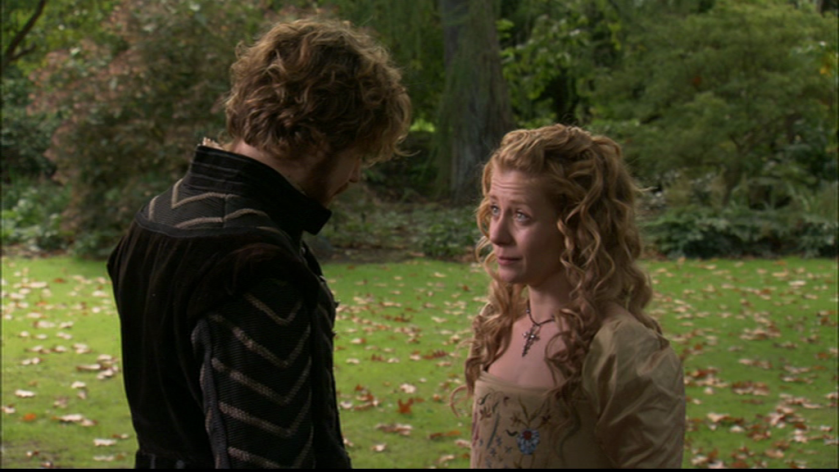
Well, I’m not sure that The Tudors demanded that no one leave a romantic relationship alive in Season 2, but they certainly wanted Thomas stripped down to his lowest ebb for the end of this Season. So showing him in a positive relationship wasn’t where the character was headed. And I would never have heard about Actual Historical Thomas and Elizabeth (Goodbye Krystin Pellerin) if I hadn’t been shown the fictional doomed version because their relationship came some time after his involvement with the woman who would be Queen, and her involvement as Katherine’s lady in waiting.
Anyway, back to the sadness.
A lot of Legacy
Mary is unpacking her bequests from her mother. Most significant is this one.  It’s the Curia’s judgement, Katherine’s most treasured possession in her exile and Mary’s legacy. The knowledge that to the world outside of England, she is Henry’s legitimate heir. Mary kisses the seal of the document, and crying stands at the window of her tiny room in Hatfield, getting ready to face the world even more alone than she was before.
It’s the Curia’s judgement, Katherine’s most treasured possession in her exile and Mary’s legacy. The knowledge that to the world outside of England, she is Henry’s legitimate heir. Mary kisses the seal of the document, and crying stands at the window of her tiny room in Hatfield, getting ready to face the world even more alone than she was before. 
Golden World
It’s May Day 1535. I know because on the bright lawn in amongst the music and the Morris dancers people are wishing each other happy May Day.
And Katherine of Aragon died January 7th 1536. Once again, Actually Historically naughty, The Tudors, once again there’s a good reason for it. Despite the dramatic joining of the fates of these women (Anne Boleyn miscarried, probably on the same day Katherine was buried, on 29th January 1536) The Tudors has moved Katherine’s death back by 8 months. And it gives everyone a bit more room. Between them Katherine and Anne have dominated seasons 1 & 2 and going straight from Katherine’s death into Anne’s fall would lessen then effect of both. This way we get more time which we need because we also now have the Seymours to develop.
So. It’s May Day 1535.
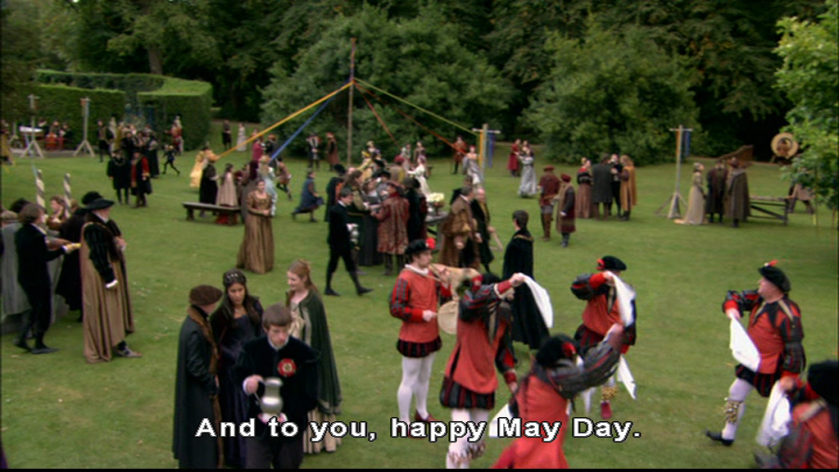
Brandon is taking the time to introduce his wife to Sir John Seymour, who is at the Archery butts. Thomas Boleyn is at the cock fighting.
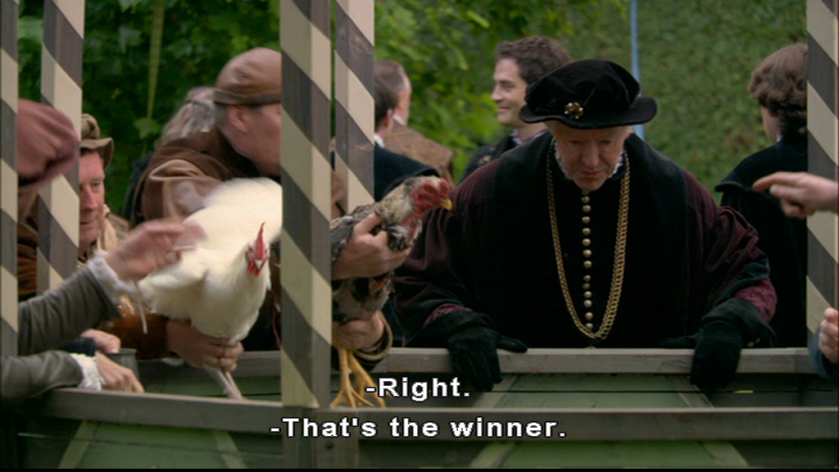
When there is a peal of trumpets and their majesties have arrived.  The whole “They wore yellow after Katherine’s death” thing is Actually Historically true, it got reported a lot of places, and the whole “But black and yellow are the colours of Spanish mourning” sounds like a useful excuse they found either before or after they did it. I’m pretty sure the proportions of black and yellow would have been radically different on Spanish mourning clothes, and note I keep saying ‘they’ because Henry did it too. Here Anne gets the excuse that it’s also definitely May Day.
The whole “They wore yellow after Katherine’s death” thing is Actually Historically true, it got reported a lot of places, and the whole “But black and yellow are the colours of Spanish mourning” sounds like a useful excuse they found either before or after they did it. I’m pretty sure the proportions of black and yellow would have been radically different on Spanish mourning clothes, and note I keep saying ‘they’ because Henry did it too. Here Anne gets the excuse that it’s also definitely May Day.
Anne has her swagger and thousand yard stare back, and all these minions saying “Your Majesty” might as well be mice.
After bowing to his sister George shows the consideration of the female viewpoint that makes him such a stunning husband. 
And walks off to talk to Mark. Mark talks about setting up an assignation tonight. George says he’s not sure, and looks over at his wife.

Henry has all the formal markers of politeness down, but he cannot wait to leave Anne behind and go talk to Sir John Seymour. She thinks he’s moving her to another arm, and his sudden walking in another direction does not please her. Officially Henry wants to thank Sir John for his hospitality during his surprise visit. Unofficially, he’s got something else he wants to ask.  As Henry goes off to play with little Elizabeth, and Sir John Seymour takes in the magnitude of the opportunity that has appeared in front of him, Anne gets waylaid by her father.
As Henry goes off to play with little Elizabeth, and Sir John Seymour takes in the magnitude of the opportunity that has appeared in front of him, Anne gets waylaid by her father.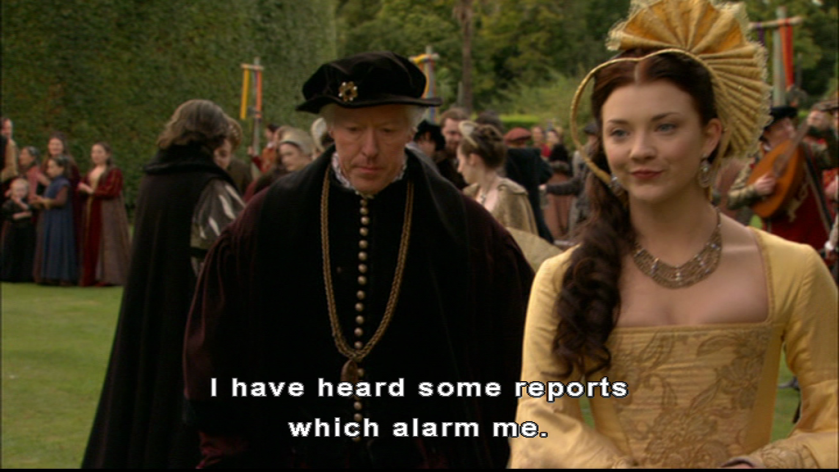
He’s heard about her disagreement with Cromwell and is (annoyingly, quite rightly) concerned. She points out that their disagreement was over important public matters. Thomas actually says he did not bring her up to have opinions, or to express them, or to quarrel with those closest to the crown. He actually grabs her arm at one point and at long last his aggression gets a clap back. 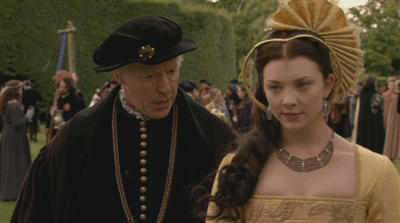 As she walks away and smiles. The smile turns into a laugh which gets bigger and bigger until even Cromwell notices and wonders what is up. And her father (who, let’s not forget has been whinging about her attitude a lot) cannot comprehend what’s changed. Well, she says there is good news all around.
As she walks away and smiles. The smile turns into a laugh which gets bigger and bigger until even Cromwell notices and wonders what is up. And her father (who, let’s not forget has been whinging about her attitude a lot) cannot comprehend what’s changed. Well, she says there is good news all around.

And as for Anne… It’s tempting to leave her there, dressed in yellow on a bright summer day, right on the edge of that Golden World.
It’s tempting to leave her there, dressed in yellow on a bright summer day, right on the edge of that Golden World.  There are worse things than leaving on a beautiful lie, after all.
There are worse things than leaving on a beautiful lie, after all.
For anyone that would prefer that, well, I’ll hope to see you at the beginning of next year for the start of Season 3. For anyone ready to brave the darkness, we start rolling towards it next week.
Notes: This one was quite the monster. Lots of important stuff, lots of Actual Historical I’d been waiting to put in. Let’s say the next one by Monday 22nd July.

Loved the actual happy ending Elizabeth got ! thanks for that
LikeLiked by 1 person
I know I’m quite late to this, but I was not impressed with how Katherine of Aragon was portrayed. The “read the Curia’s decision to me again” sounded utterly pathetic.
For the other queen, I pity her. Anne is a victim in all this, even if to some extent she’s a victim of herself. I cannot help but to remember her pre-coronation talk with Francis where he mentioned the royal lifestyle is not actually a good thing. His words echoed in my mind throughout Anne’s downfall.
Thats what The Tudors did very well. It demonstrated that in a turn of irony, sometimes Kings and Queens are actually pawns who are manipulated by those seeking more power.
LikeLiked by 1 person